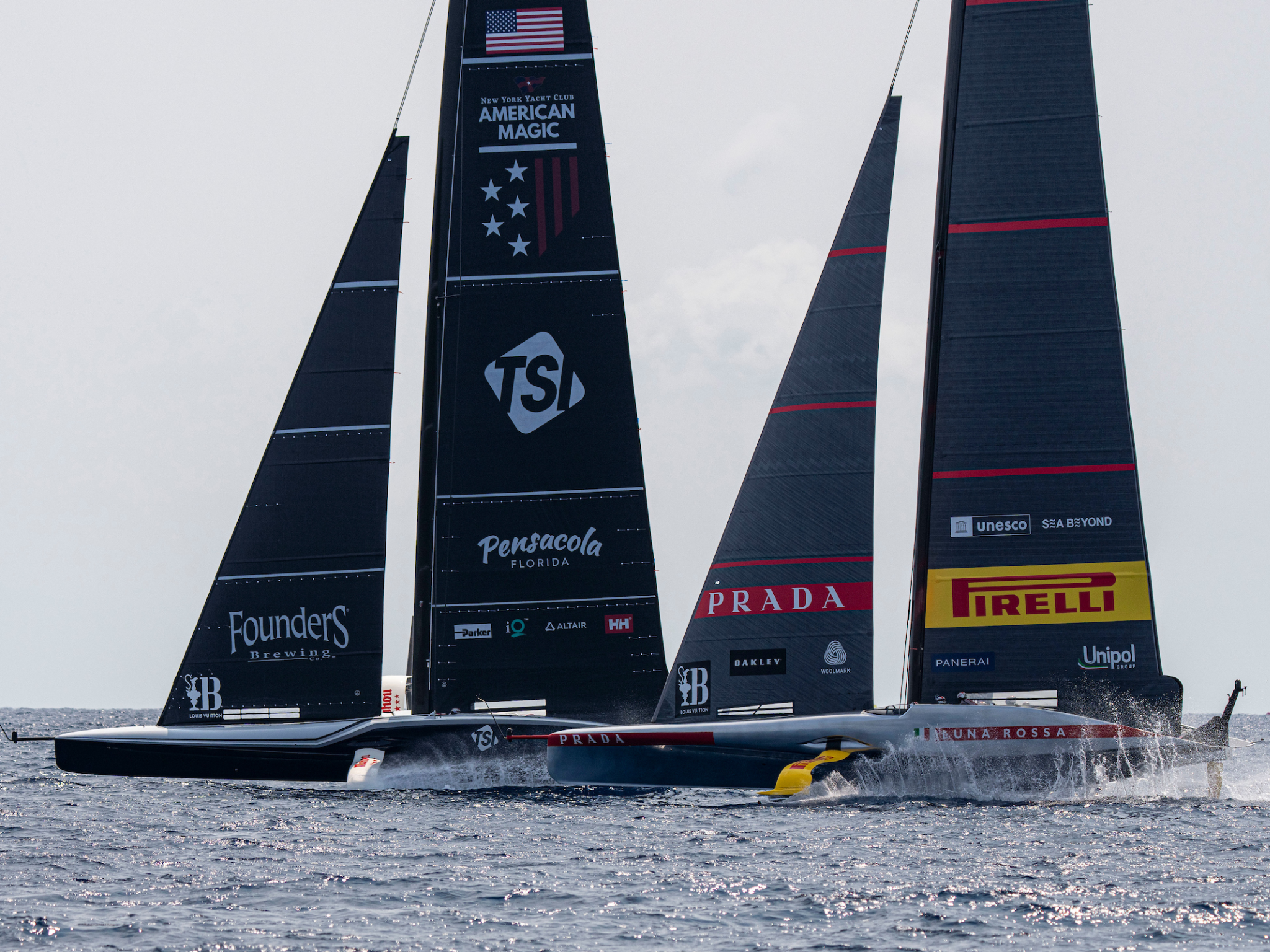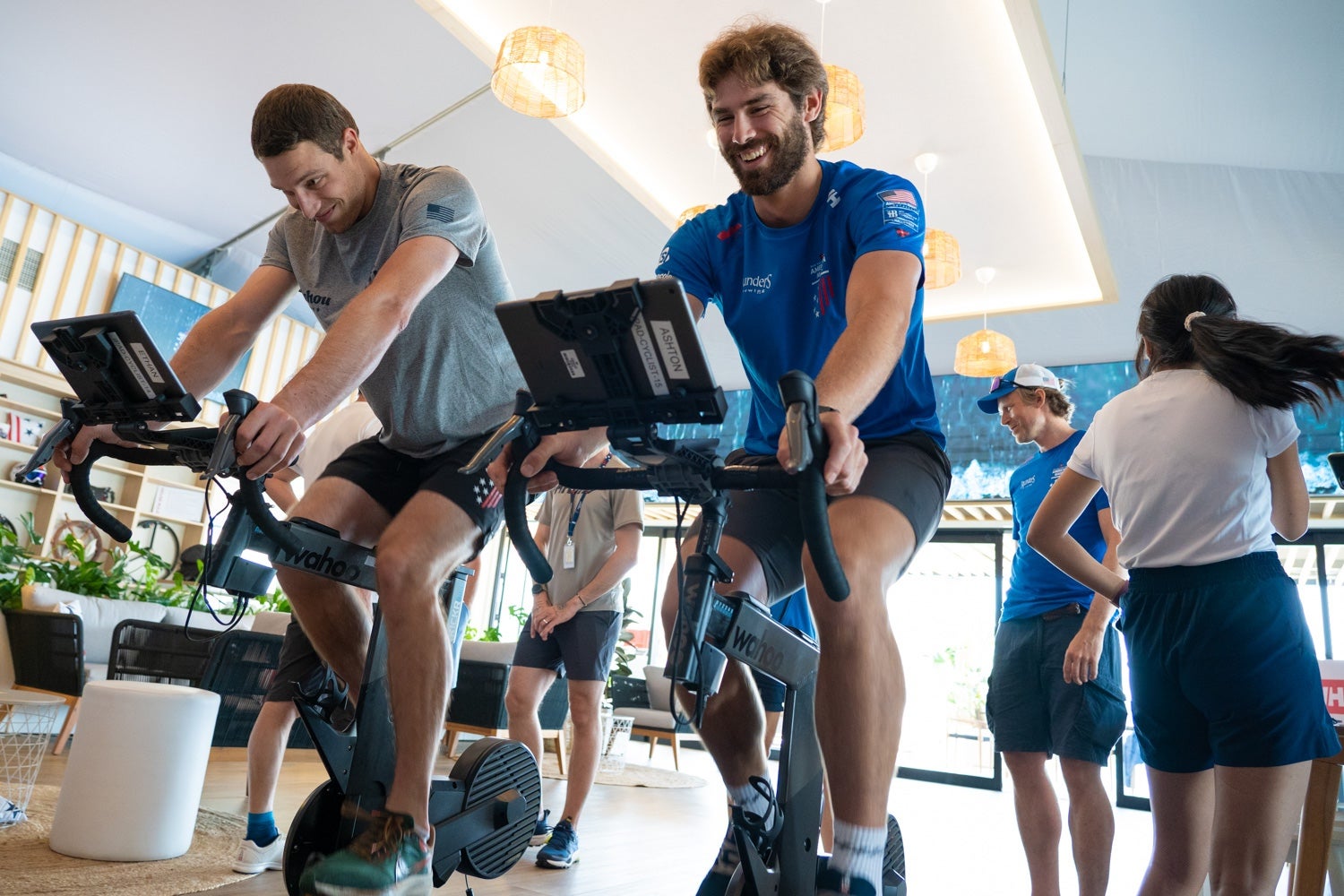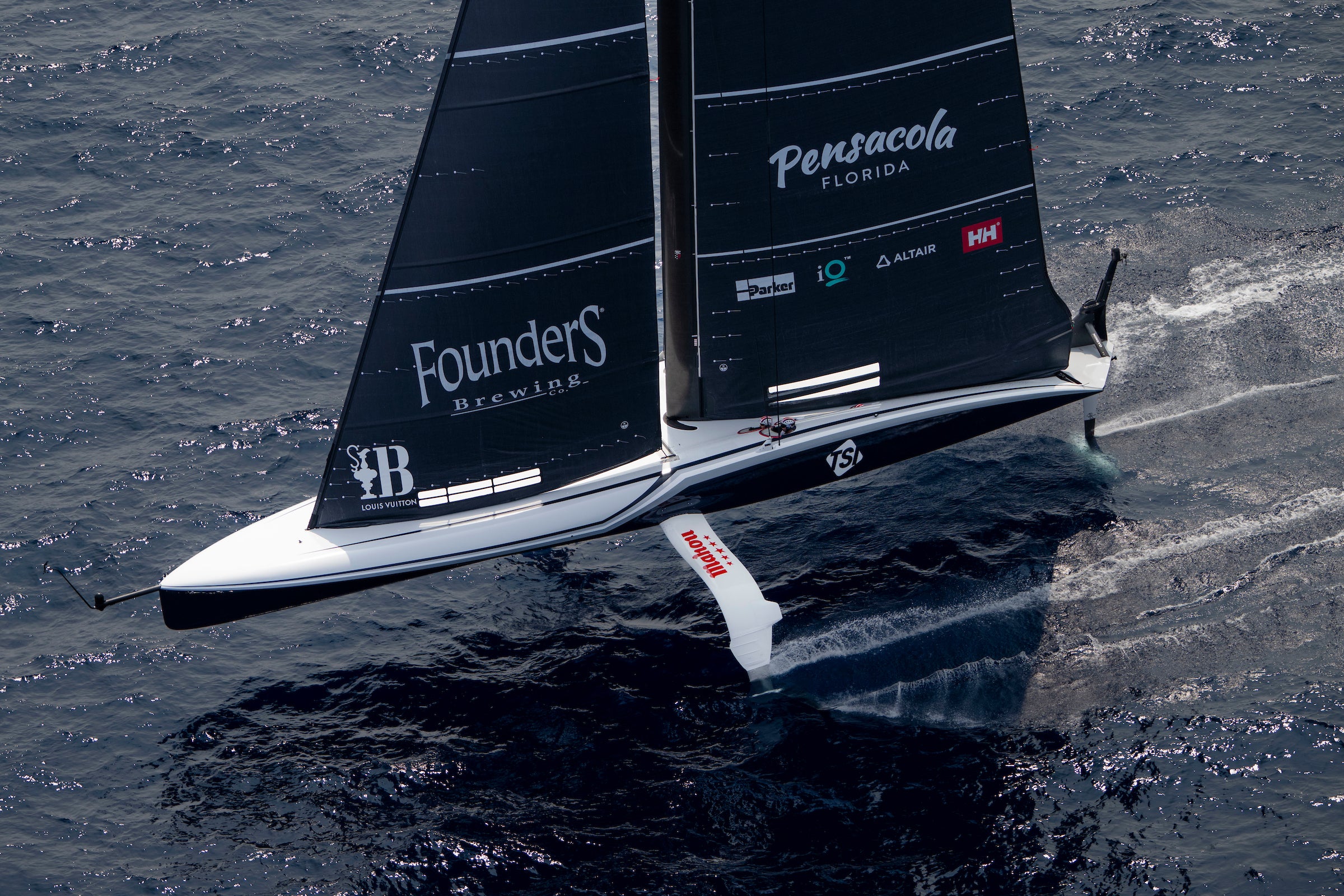Inside the America’s Cup: The history, heroism and high stakes that make the competition one of the greatest in sport
More than 170 years since the trophy was first contested, sailing’s most glamorous event is about to hit the water off Barcelona. Christian Broughton joins the preparations, with Olympic gold-winning sailors, boats that almost fly, and some of the most powerful athletes in world sport

Your support helps us to tell the story
From reproductive rights to climate change to Big Tech, The Independent is on the ground when the story is developing. Whether it's investigating the financials of Elon Musk's pro-Trump PAC or producing our latest documentary, 'The A Word', which shines a light on the American women fighting for reproductive rights, we know how important it is to parse out the facts from the messaging.
At such a critical moment in US history, we need reporters on the ground. Your donation allows us to keep sending journalists to speak to both sides of the story.
The Independent is trusted by Americans across the entire political spectrum. And unlike many other quality news outlets, we choose not to lock Americans out of our reporting and analysis with paywalls. We believe quality journalism should be available to everyone, paid for by those who can afford it.
Your support makes all the difference.It’s impossible not to feel the adrenaline rush as the 75ft yacht races by, like a surreal reimagining of Formula 1, with shades of Star Wars, set on the high seas. The speed is breathtaking, but it’s the silence that gives this scene its sci-fi twist.
We’re a few hundred metres off Barcelona’s packed beaches, and Patriot, the New York Yacht Club’s entry into this year’s America’s Cup, is out on the water for a training day. The teams in this year’s competition are hoping to break 50 knots (92kph), yet this boat leaves barely any wake, makes not a sound, and as the sails twitch tight and the hull rises from the sea, it leaves our powerboat for dead. Scarcely touching the water, with only two hydrofoils beneath the surface, this thing really flies.
Is there anything in international sport that’s bigger than the Olympics? In sailing, there’s the America’s Cup. While the Games are the proving ground where sailors do battle in dinghies, this competition, dating back to 1851 and the oldest international competition in sport, will be contested in 75ft yachts with costs rumoured to run into eight figures. The latest edition of the race starts this month and will be run over several races until late October.
There’s something eerie about seeing so much power and control up close, and it’s not just the spectators who feel this way.
“You can’t be scared of these boats,” says Paul Goodison, one of the two helms in charge of Patriot. “You have to keep pushing. As soon as you start backing off is probably when you’re going to get bitten, so you always have to keep your foot down, and keep pushing, pushing, pushing.”
Goodison won gold for Team GB in Beijing in 2008 in the Laser class, while Ben Ainsley, his compatriot and the most decorated Olympic sailor in history, was winning gold in the Finn. Now they compete against each other, Ainsley in the British boat, INEOS Britannia.
For months the America’s Cup teams have been in testing around the port of Barcelona, finding the angles and sail set-up that gives maximum speed in different conditions on the local waters. There is a huge team supporting the sailing crew, forming a portside pitlane of assembled talents, from data scientists to naval architects. But when they finally line up against each other, it’s the skippers’ old rivalries that will be the focus of attention. Maybe even within the same team.
Each boat has two helms, or skippers, one on each side of the same boat, handing control to each other as the boat turns and the sail sweeps across, restricting visibility.
Goodison’s fellow helm is the Australian Tom Slingsby, last year’s Rolex World Sailor of the Year. The personal histories and rivalries have run for decades. Slingsby was on the crew of the US boat in the 2013 America’s Cup, alongside Ben Ainsley, as they scored one of the most famous and tight come-back victories in the competition’s history. And Slingsby won his Laser gold medal, at the London Olympics in 2012. All sports have their elite competitor dynamics, but in the America’s Cup, these are off the charts.
“We’ve competed against each other in the Olympic classes for the best part of 10 years,” says Goodison of his teammate. “We were archrivals for a long time. And we’ve been through cycles of being best mates, and then very abrasive, and then mates, and then abrasive. And it all comes from when you’re competing against somebody. You can’t really like them. You’ve got to crush them. You’ve got to beat them. And that was a big part of the Olympic cycle. But also with that, you gain a huge amount of respect. If you were to choose another guy to be beside you racing one of these, he’d be top of your list.”

The stakes are high. Though the US had the longest winning streak in sport, taking the first competition and then holding the America’s Cup for 132 years, it is Emirates Team New Zealand that currently holds the trophy. Last time around, in 2021 off the shores of Auckland, the American Magic team were thought to have the fastest boat in the fleet. They were clear of their Italian rivals, Prada, in the semi-final. But as they turned the mark, the boat overpowered, tipped, soared into the air and crashed back down, capsizing and very nearly sinking. The final was so close. Human error – though, it must be said, not Goodison’s.
But there is more to an America’s Cup crew than the skippers who make those high-pressure decisions. To see the boats glide by does not do justice to the muscle power on board. While the two lifting hydrofoils are controlled by electrical power, the huge, powerful sails are adjusted by the “meat batteries” (is there a more brutal description for a professional in all of sport?).
It’s a long time since America’s Cup boats used simple winches. Legs are far more powerful than arms, so these boats have ‘cyclors’ on board, with bike frames hidden within the hull, as the crew pedal furiously to power each turn.
For the American Magic team, this role is made all the more brutal by the demands of aerodynamics. Patriot is designed to be much sleeker and much more low-profile than her rivals – especially Ainsley’s muscle-car-looking INEOS Britannia. And that means the Patriot’s cyclors are pedalling for all their worth on recumbent cycles, facing backwards. “I hope they’re paying those guys well,” a rival team’s cyclor quipped later that day.
These “meat batteries” are serious units, chosen from backgrounds ranging from cycling to rowing – sports that demonstrate an ability to churn out power that’s beyond almost anyone else.
If the boats are space-age machines steeped in sporting heritage, so too is the gear the crew wears. American Magic have been working closely with Helly Hansen – the outdoor gear label that traces its own roots back almost as far as the competition, to Norway in 1877. Their technology team have been working with the sailors throughout, redesigning fabrics to be lighter and more flexible, changing the cut of the spray tops to allow ideal movement, and even rethinking the design of the buoyancy aids.
But even the Helly Hansen performance team were not prepared for the cylcors. As they worked with the boat’s big beasts, they discovered they had to cut the legs of their kit much wider to accommodate all that power and make the fabrics capable of dumping huge amounts of body heat.
If you want to write your own name into America’s Cup history, and you don’t have an Olympic sailing gold to hand, you might consider becoming a cyclor. To apply for this most gruelling physical test in sport, you’ll only get the attention of American Magic’s head of performance, Ben Day, if you can already send huge power through your training bike. This is not about being light yet powerful – it’s not the Tour de France, you’re not cycling up a mountain. This is all about “absolute watts”.
If you can sustain around 450 watts for 20 minutes, and peak at 1,000 for 30 seconds, “then, I say, let’s have a chat,” says Day. But look down at the wattage at the peak of your spin class or Peloton session and you might see a humbling comparison. I know from experience. After some gruff encouragement from Day, I gave it my all. Did I hit 450 watts? Yes. Did I hold it for 20 minutes? It was a struggle to hold it for one. And this was in the air-conditioned, stable luxury of the American Magic base camp.

It’s all a long way from the competition’s beginnings. Back then, it was the year of the Great Exhibition, and the Royal Yacht Squadron, based in Cowes on the Isle of Wight, off England’s south coast, had invited the New York Yacht Club to join them.
The script was clear: the regatta was set to be a showcase of maritime supremacy, a demonstration of just how invincibly Britannia ruled the waves. But what played out on the water was one of the greatest upsets in sporting history.
A radically designed 100ft schooner with concave bows, slick black hull and flat sails, America had proven herself capable of clocking up more than 200 miles in a day as she crossed the Atlantic. Backed by a syndicate, Stevens had commissioned local brothers James and George Steers to build her, negotiating the price down to $20,000 ($814,000 today).
The yacht’s captain was Richard Brown, a renowned Sandy Hook pilot, with skills forged in the sharp-edged competition of the new world, navigating tricky waters at pace to beat the local competition to incoming ships and win the business of guiding them into the booming harbour of New York.
Accounts of exactly what happened upon America’s arrival in British waters are disputed – as can be the case when pride and reputation are at stake, and the sporting action takes place out at sea, away from the gaze of too many witnesses. She may – or may not – have left a renowned local boat in her wake in an initial encounter. Certainly, the locals seemed intimidated after that initial skirmish, with the American crew forced to wait for someone to accept their challenge. “It could not be imagined,” wrote The Times, “that the English would allow an illustrious stranger to boast that he has flung down the gauntlet to England and had been unable to find a taker.’’
Some days later, on 22 August, the now infamous challenge was set. A £100 ewer, from the London silversmith Garrard, was to be the prize. Fifteen yachts – seven schooners and eight smaller cutters – officially started the 53-mile course, running clockwise around the island. One of the favourites ran aground, and another went to help, pulling out of the race. Two others crashed into each other. And so the challenger from across the Atlantic took the spoils.

One of the two yachts that collided off Ventnor that day was named Volante, Italian for “flying”. A glimpse of the future, perhaps, and of the yachts that today hover above the waves.
As American Magic’s training day nears its end, the challenger from Italy, Luna Rossa Prada Pirelli, bankrolled by the fashion house billionaire Patrizio Bertelli, emerges, shimmering in its mirrored silver finish. The two boats tack near each other, then pull away, honing their skills as they drop their foils into the water, turn through the wind and then speed off with just one foil and the rudder touching the water.
At this stage, it’s a practice only – the rules strictly prohibit them from lining up against each other until the competitive action begins. But with so much money, pride and history at stake, you can tell they’re sparring, seeing where the other boat looks slicker and quicker. Come Thursday (22 August), as the 37th America’s Cup finally takes to the water, the real race – one of the greatest and most glamorous in sport – will be on.
To watch the America’s Cup: americascup.com
The author travelled to Barcelona with Helly Hansen: to see the Helly Hansen American Magic crew clothing, visit hellyhansen.com




Join our commenting forum
Join thought-provoking conversations, follow other Independent readers and see their replies
Comments